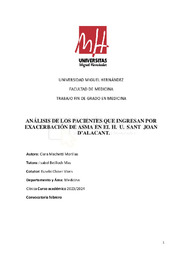Por favor, use este identificador para citar o enlazar este ítem:
https://hdl.handle.net/11000/31743Análisis de los pacientes que ingresan por exacerbación de asma en el H.U. Sant Joan d'Alacant
| Título : Análisis de los pacientes que ingresan por exacerbación de asma en el H.U. Sant Joan d'Alacant |
| Autor : Machetti Morillas, Clara |
| Tutor: Betlloch Mas, María Isabel Chiner Vives, Eusebi |
| Editor : Universidad Miguel Hernández |
| Departamento: Departamentos de la UMH::Medicina Clínica |
| Fecha de publicación: 2024-01-31 |
| URI : https://hdl.handle.net/11000/31743 |
| Resumen : INTRODUCCIÓN A pesar de disponer de un tratamiento efectivo, las hospitalizaciones por asma siguen siendo relevantes en la actualidad siendo causa de morbilidad y altos costes económicos. OBJETIVOS Analizar las características de los pacientes ingresados por exacerbación de asma y determinar la optimización, grado de adherencia al tratamiento y seguimiento en consultas de neumología y atención primaria. METODOLOGÍA Se incluyeron pacientes ≥18 años ingresados en el Servicio de Neumología del Hospital Universitario San Juan de Alicante de mayo de 2021 a junio de 2023 con diagnóstico principal de exacerbación de asma. Se excluyeron pacientes con diagnóstico secundario de exacerbación de asma y sin diagnóstico de certeza. RESULTADOS Se analizaron 186 pacientes (237 ingresos), 63% mujeres, 49±34 años (>65a: 40%), IMC 26.4±5 kg/m2, IgE 132±235 UI/mL (25-2041), 180±443 eosinófilos y estancia media 8,6±5 días. Comorbilidades más frecuentes: rinitis 66%, poliposis nasal 63%, anosmia/hiposmia 64% y dermatitis atópica 40%. En tratamiento con: dosis altas de CSI/LABA 100%, montelukast 45%, LAMA 48%, tratamiento biológico 20%, antihistamínicos 15%, xantinas 3%, esteroides orales en 8%. Respecto a la gravedad y control presentaron asma intermitente 3%, persistente leve 13%, persistente moderado 64% y persistente grave 20% con ACT (17±2) y ACQ (1,5±1). El 19% pacientes tuvieron >1 ingreso precisando 5 de ellos estancia en UCI sin fallecimiento. Comparando pacientes con 1 ingreso o más, se observaron diferencias en edad (39±15 vs 58±20, p<0,0001), IMC (25,2±3 vs 27,4±4, p<0,0003), comorbilidad (15% vs 60%, p<0,0001) y estancia media (4,5±2 vs 11±3, p<0,0001). El 15% presentan asma no conocido, el 28% asma conocida sin terapia de mantenimiento, el 23% control por atención primaria y el 34% seguimiento por neumología. El 52% presentan espirometría previa con diferencias significativas entre neumología y primaria (100% vs 24%, p<0,001). La puntuación media del TAI fue 42,5±8 puntos (buena adherencia: 28%, adherencia intermedia: 26% y mala adherencia: 46%). El 70% presentó incumplimiento errático, el 46% deliberado y el 21% inconsciente. CONCLUSIONES La población joven supone un porcentaje importante de ingresos por exacerbación debido al escaso seguimiento en consultas de neumología, mala adecuación del tratamiento y bajo cumplimiento. Los fármacos biológicos disminuyen los ingresos y uso de recursos. INTRODUCTION Even with an effective treatment in place, hospitalizations for asthma continue to be significant today. OBJECTIVES To analyze the characteristics of patients admitted for asthma exacerbation and determine the optimization, level of treatment adherence, and follow-up in pulmonology and primary care consultations. METHODOLOGY Patients aged ≥18 years admitted to the Pulmonology Department of the San Juan de Alicante University Hospital from May 2021 to June 2023 with a primary diagnosis of asthma exacerbation were included. Patients with a secondary diagnosis of asthma exacerbation and without a confirmed diagnosis were excluded. RESULTS A total of 186 patients (237 admissions) were analyzed, with 63% being women, an average age of 49±34 years ( >65 years: 40%), an average BMI of 26.4±5 kg/m2, IgE levels of IgE 132±235 UI/mL (25-2041), 180±443 eosinophils, and an average length of stay of 8.6±5 days. The most common comorbidities included rhinitis (66%), nasal polyposis (63%), anosmia/hyposmia (64%), and atopic dermatitis (40%). Regarding treatment, 100% were on high-dose ICS/LABA, 45% were taking montelukast, 48% were on LAMA, 20% were on biological treatment, 15% were taking antihistamines, 3% were using xanthines, and 8% were on oral steroids. Regarding asthma severity and control, 3% had intermittent asthma, 13% had mild persistent asthma, 64% had moderate persistent asthma, and 20% had severe persistent asthma, with ACT scores of 17±2 and ACQ scores of 1.5±1. Nineteen percent of patients had more than one admission, with 5 of them requiring ICU stays without fatalities. When comparing patients with 1 or more admissions, differences in age (39±15 vs. 58±20, p<0.001), BMI (25.2±3 vs. 27.4±4, p<0.003), comorbidity (15% vs. 60%, p<0.001), and average length of stay (4.5±2 vs. 11±3, p<0.001) were observed. Fifteen percent had unrecognized asthma, 28% had known asthma without maintenance therapy, 23% were under primary care control, and 34% were under pulmonology follow-up. Fifty-two percent had previous spirometry, with significant differences between pulmonology and primary care (100% vs. 24%, p<0.001). The mean TAI (Test of Inhaler Adherence) score was 42.5±8 points (good adherence: 28%, intermediate adherence: 26%, and poor adherence: 46%). Seventy percent had erratic non-adherence, 46% had deliberate non-adherence, and 21% had unconscious non-adherence. CONCLUSIONS The young population accounts for a significant percentage of admissions due to exacerbations, primarily due to inadequate follow-up in pulmonology consultations, inappropriate treatment adjustment, and low adherence. Biological drugs reduce hospital admissions and resource utilization |
| Palabras clave/Materias: Asma bronquial exacerbación hospitalización adherencia al tratamiento. |
| Área de conocimiento : CDU: Ciencias aplicadas: Medicina |
| Tipo de documento : info:eu-repo/semantics/bachelorThesis |
| Derechos de acceso: info:eu-repo/semantics/openAccess Attribution-NonCommercial-NoDerivatives 4.0 Internacional |
| Aparece en las colecciones: TFG- Medicina |
 La licencia se describe como: Atribución-NonComercial-NoDerivada 4.0 Internacional.
La licencia se describe como: Atribución-NonComercial-NoDerivada 4.0 Internacional.
.png)
